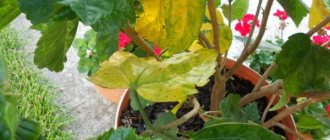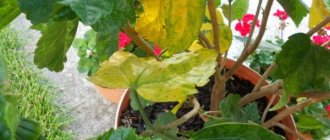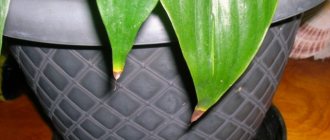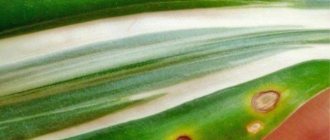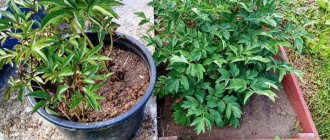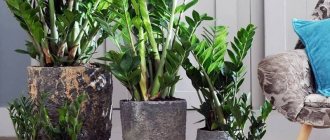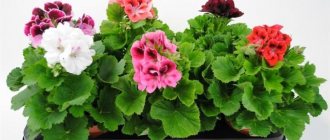Indoor bamboo, or Dracaena Sendera, as it is also called, often gets sick. Flower growers often encounter such a problem as yellowing of the leaves and trunk of the plant. Often it is not so difficult to revive the plant, but sometimes yellowness can cause the development of diseases that destroy the dracaena.
Why bamboo turns yellow, what problems precede this, as a result of which the plant takes on a sickly appearance – these are popular questions among those who grow or want to buy young indoor bamboo, which is also called Sender’s dracaena, for their apartment or house. Therefore, we will try to understand the topic during the course of the article.
You may be interested in:Flower for home well-being: signs for attracting happiness, name, description with photos and care tips
Dracaena leaves turn yellow and fall off: what could be the reasons?
Dracaena gives any interior an exotic look. It is also called palm or false palm. Yellowing of leaves can be caused by a number of reasons. There are cases when even the most experienced gardeners cannot understand why dracaena leaves turn yellow and how to help it. And sometimes even if you take proper care, it is not enough.
Various reasons lead to yellowing of foliage
The most common reasons for the appearance of yellow leaves in dracaena:
- natural aging. The lower leaves of the flower turn yellow and die, and this is a normal process. If the stem is tall and elongated, the main trunk should be cut off to allow new stems to grow and tillering to increase;
- excess moisture. Too much moisture is another cause of yellowing leaves. Waterlogged soil and lack of drainage provoke root rot, which leads to weakened immunity and the development of diseases, the symptoms of which can be determined by the condition of the leaves. By watering once a week, you can improve the condition and color of the leaves;
- lack of humidity. This factor also affects the condition of the flower and causes the dracaena to appear yellow leaves. Tropical plants grow well in conditions of high humidity; dry air in city apartments is contraindicated for them. The plant should be regularly sprayed and moistened, especially in winter, when the air in homes is too dry. You can place containers filled with water next to the pot to increase the humidity in the room;
- direct sunlight. They are harmful to the leaves as they cause them to turn yellow. It is important to choose the right place where the flower will stand. Dracaena should always be protected from the sun;
- lack of light. In low light, the plant turns yellow, starting from the lower leaves, then the leaves fall off. Sometimes the leaf blade turns yellow when one side is in the shade. Therefore, the flower should be rotated periodically to ensure even exposure to light;
- viral infection. If the plant is infected with a virus, the first symptom will be yellow foliage. The leaf blade and stem are also deformed. The infection is contagious, so it can spread to neighboring indoor flowers;
- pests Spider mites, thrips, and scale cause yellowing of the leaves and the appearance of additional symptoms, such as brown spots on the stems, grayish plaques on the leaves, or thin whitish marks. Pests suck out the cell sap, so the leaves turn yellow and fall off.
Finding out why the leaves began to turn yellow is not so difficult. You should analyze the care of the flower and correct errors.
Note! Yellowing of the lower leaves is a normal natural phenomenon for a houseplant. In order for new foliage to appear, the flower needs to get rid of the old one. But if yellowing occurs en masse, this most often indicates the development of the disease.
Direct sunlight as a factor in plant disease
This is another common reason why indoor bamboo turns yellow. The plant reacts sharply and extremely negatively to bright sunlight. When exposed to direct rays, the leaves become covered with small yellow spots, and then completely turn yellow, subsequently falling off. If you don't remove the bamboo from the bright sun, you risk losing the plant. That is why well-coordinated care for it is so important, because any deviation from the norm causes resistance on the part of the flower, which threatens to result in the loss of a favorite plant for the grower.
Diseases
Why do dracaena leaves fall off - reasons
The cause may be too dry air, too low a temperature or sudden changes in the environment. If you move a dracaena, for example, from a cool street to a warm apartment, this can lead to cracking of the edges of its leaves. In addition, you should not expose the plant to temperature fluctuations. Yellowing of the leaf blade is guaranteed.
One of the symptoms of the disease is yellow leaves
Dracaena diseases can also occur as a result of excessive sun exposure, which leads to burns on the leaves. In turn, too little light can lead to fading and weaker colors found in some varieties. Slowing growth, transparency of leaves, as well as their yellowing and falling off are possible consequences of improper propagation of dracaena.
Most often, the flower is affected by infectious diseases. They are transmitted from neighboring plants and brought in with tools while loosening the soil. If you ignore the yellowing of the foliage and do not take action, the dracaena will soon die.
Important! The infection can be brought into the house with other indoor plants from a store or market, as well as with untreated garden tools.
Bacterial infection
A bacterial infection on dracaena appears as dark brown, rapidly growing spots on the tips of the leaves. Sometimes the stem also turns black at the base and the rot moves to the petioles. The result may be an unpleasant odor. For mild infections, remove diseased leaves and spray the plant and substrate with a growth stimulant, which reduces the development of spot disease. Unfortunately, once the disease is advanced, it is no longer possible to save the plant.
Bacteria attack leaf tips
Fungal infection
May have a bacterial or fungal basis. Yellow, brown, irregular spots ranging in size from 1 to 5 mm with a red border appear on the leaves of dracaena. On top of them are black clusters of fungal spores. It is important to remove the affected leaves and stop spraying the plant. To preserve dracaena, a series of biological products and fungicides should be used.
Fungal disease
Note! To prevent fusarium spotting, you need to take the same preventive measures. With this disease, rotting of the leaf rosettes is observed, and small watery spots with a light yellow border appear on the leaf blades.
Mold in the soil
Mold in the soil damages most houseplants. Its appearance is promoted by poor soil quality, lack of light, high air and soil humidity, and excessive watering. If mold is detected in the spring, it would be advisable to transplant the plant into fresh soil with a loose substrate, preferably with a drainage layer.
This is what mold in the soil looks like
Blackening of foliage
The tips of the leaves may turn black. The causes of this problem most often lie in the conditions in which the indoor palm tree is kept.
Today, the following factors are known to cause blackening of foliage in palm plants:
- Dry air predominates in the room.
- The palm tree is not watered properly.
- The influence of cold air currents.
- A compacted earthen lump.
To help the plant, you don’t need to do anything special, just eliminate the cause of the problem. Flower growers recommend fertilizing with fertilizers.
Pests
Why Dieffenbachia leaves turn yellow - reasons
Failure to follow the rules of care leads to parasites attacking the dracaena. Sucking the juices from the leaves leads to the slow death of the flower.
Pests can destroy a flower overnight
Dracaena pests:
- thrips. This is the most dangerous parasite that attacks indoor plants. Its length is only 1.5 mm. Pests, settling on the foliage from below, begin to actively suck out the cell sap. The females gnaw through the tissue, causing the leaf blade to turn yellow. As a result, the foliage dries out and falls off. High room temperature leads to their rapid reproduction. To save the flower, dracaena leaves are sprayed with a soap solution and covered with a plastic bag. A sticky trap also reduces the number of pests. In addition, drugs such as spark, fitoverm help;
- Mealybugs. This insect can be seen with the naked eye. On top it is covered with a white waxy coating. Females and larvae suck the juice from the cells, disrupting the development of the flower. Moving quickly, they leave behind a whitish coating. Using a toothbrush dipped in soapy water, you can remove waxy traces of parasites. Akhtar, fitoverm or calypso will help save dracaena in case of severe damage;
- scale insect A common parasite among indoor plants. This arachnid is covered on top with a protective shield. The female lays a huge number of larvae, which, like adults, are covered with scutes. They are securely attached to the foliage and suck the juice from it. Dracaena stops developing, turns yellow, dries out and dies. Treatment is carried out using a sponge and methyl alcohol (very carefully). Once weakened, the pests are destroyed with drugs such as Inta-SM or Actara. Yellow leaves of the plant must be removed.
Important! After treating the plant with chemicals, it is necessary to replace the top layer of the substrate.
How to water palm trees
The date palm is very demanding on the quality of water, as well as its temperature, which should be from +30 to +34 °C. Water at room temperature cannot be used for watering palm trees, even in summer.
In order to prepare water at a suitable temperature, add hot water to a container with cold water.
With proper watering, all vessels of the root system are preserved, which provide the plant with normal nutrition and sufficient moisture supply. When watering with purchased water, you must first familiarize yourself with its composition.
Water in small portions over the entire area. The soil in the pot should be completely saturated with moisture so that the tray begins to fill. Only in this case can you understand that the entire root system has access to water. The liquid accumulated in the pan must be drained after 30–40 minutes. Otherwise, the roots, without access to air, may begin to rot. The time of the next watering depends on the condition of the soil. The top layer should dry completely, and the soil at the edge of the pot, at a depth of 3 cm, may have slight moisture.
Soil moisture
Why do geranium leaves turn yellow at home - causes and treatment
Dracaena is a plant that came to Russia from countries where drought alternates with heavy rains. This led to the fact that the plant acquired special properties that make the flower resistant to irregular watering. However, these changes that nature gave to the flower become a huge disadvantage when the plant is in a constantly humid environment.
Proper watering will be a good preventative against yellowing of foliage.
The best way to water this plant is by immersion method:
- Partially fill a sink or large container with water.
- Place the pot. The water should reach the level of the soil in the pot.
- Soak the pot of dracaena in water for 7-10 minutes.
- Lift the pot and place it on a wire rack to allow any excess water to drain.
- When the dripping has stopped, return the plant to its place.
You can water the next time only when the soil is completely dry. To check, you should deepen your finger 5-8 cm. It should be dusty and dry. If there is even a little moisture left, there is no need to water. It is important to periodically loosen the substrate. This will saturate it with oxygen and become a good preventative against diseases.
Note! Experienced gardeners assure that dracaena needs to be watered every 5-7 days.
In winter, dracaena is dormant. At this time, the same rules as above apply, except that it may take up to a month for the soil to dry out from the previous watering. You can water every 15-30 days. There is no need to moisten the soil weekly.
Why does the IKEA flower turn yellow?
The IKEA store sells bamboo without soil. After purchasing it, you need to put it in water, and after 2-3 months, transplant it into the ground.
Dead or limp roots are cut off and yellowed areas on the leaves are removed.
During planting, be sure to make holes in the bottom of the pot and provide a drainage system. The plant begins to sprout new branches.
Important! When the bamboo trunk is standing in water, it is also necessary to provide fertilizing.
The water is changed every 3 days. Only settled liquid can be used. You can use artificial soil - hydrogel. It is intended for dracaena, bamboo, lilies.
The soil looks like small dry balls that absorb moisture and increase in size. The hydrogel absorbs fertilizers and fertilizing well.
It is recommended to add to the soil to already formed plants. The soil will help normalize watering.
Root rotting
The fact that the leaves have begun to turn yellow may indicate that the roots have begun to rot due to excess moisture.
Rotted dracaena roots
How to understand that the soil is waterlogged:
- damp, undried soil smells of dampness and mold;
- Having buried your finger 2 cm, you can feel that the soil is damp;
- when using mulch, it signals an excess of moisture by turning black;
- There will be stagnation of water in the container under the pot.
Important! A drainage layer in a pot with dracaena will allow you to control comfortable soil moisture. During replanting, a new layer should be used.
Prevention
What measures can be taken to ensure that indoor bamboo remains green and does not turn yellow?
Pot
Choose deep pots for planting the plant, as its roots grow just deep. The diameter should not be wide. Such a container will optimally satisfy the specific requirements of the plant for its place of residence.
Transfer
Carry out this procedure regularly, without waiting for the bamboo to signal with its yellow leaves that it is cramped. In addition to being cramped, the soil in the pot is also depleted, which can also affect the appearance of the plant.
Other Possible Problems
Most often, the leaves of a houseplant turn yellow due to improper watering or excess sunlight. But there are also others that novice gardeners may not be aware of.
Among them:
- cold and drafts have a negative effect on tropical plants. Dracaenas do not like to grow near air conditioning, ventilation holes and open windows, and every movement of air masses is immediately reflected in the appearance of the plants: yellow leaves or pale spots appear between the veins. It is better to place an indoor flower at home in a quiet place;
- transfer. In order for the flower to grow well and have abundant foliage, it must be replanted periodically. If the plant's leaves begin to turn yellow, become spotted, or fall off, it's time to change the pot and soil. Usually, when dracaena grows for more than three years in the same substrate, it grows poorly. The thing is that a huge amount of salts begin to accumulate in the old soil, which prevent the flow of nutrients to the above-ground part. In order for the flower to feel good, it is recommended to replant every two years (in spring). For looseness, add a little sand or charcoal to the soil mixture. In addition, it is necessary to replace the top layer of soil with a new one every year;
- nutritional deficiency. If yellow leaves begin to appear at the top of the plant, this symptom is likely due to nutrients in the soil. This is caused by too much calcium in hard water or too little nitrogen in the soil. This problem can be solved by using nitrogen fertilizers or replacing irrigation water;
- excess nitrogen fertilizers. Irrational use of fertilizers leads to leaves falling off, sometimes they do not even have time to turn yellow.
Dracaena is a beautiful and beloved indoor plant. With proper care, it delights with its abundant bright green foliage. The flower begins to shed its leaves after two years. These are natural processes. Yellowing of the leaf blade also does not always indicate developmental disorders or the presence of diseases. Old foliage on the lower tiers should turn yellow and then fall off. But excessive yellowing, falling off and additional symptoms should alert you. After finding out the cause and working on the errors, the plant will begin to grow with renewed vigor.
Care measures
What to do if the foliage of indoor bamboo turns yellow - then general care measures.
Cut off the yellowed fragments with a sharp and clean knife/scalpel. You should not leave even very small fragments with spots, yellowness or dots - these can be breeding grounds for infection.
After pruning, you need to leave the plant alone for 3-4 hours so that the cut can dry out a little. Then, for disinfection purposes, sprinkle the cut areas with charcoal or activated carbon powder. The plant will begin to absorb the powder, and after 3-4 hours remove the remaining substance with a cotton swab.
Apply wax putty on top of the cuts and directly on the charcoal powder: you can use either purchased special wax or use paraffin from a regular candle. After this, measures are taken depending on the specific reason for the yellowing of the bamboo.
How to save a flower from death when the leaves wither and fall, tips
When a flower dies and withers, the leaves dry out and fall off. Causes:
- lack of light
- overwatering
- installing a flowerpot under the scorching rays of the sun
The dracaena has faded and dried out.
The salvation of the dracaena lies in normalizing the necessary conditions for its successful growth and development. In winter, additional lighting should be provided if necessary.
Important:
- maintain the room temperature at 19-25 degrees
- place flowerpots in a warm room
- prevent leaves from freezing during the cold season
- spray more often with warm water
- maintain optimal air humidity, not higher than 60%
- do not place flowerpots near radiators and radiators
- Spray the leaves daily with warm water to prevent drying and yellowing
- do not water frequently , over-moistening the soil.
Professionals advise:
- water the plant only when the top layer of soil has dried up to 2-3cm
- only settled water for irrigation
- periodically change the top layer at least once a month for better air penetration to the roots.
- limit the watering regime if the leaves begin to dry out and turn yellow
- Properly organize hydration of dracaena in the heat
- equip the flowerpots with soft and loose soil, laying drainage on the bottom for the unhindered flow of water to the roots of the flower, and also fertilize with useful components
- replant 2 times every two years , using the transshipment method, i.e. replace the substrate, equip it with charcoal and change the top layer of soil every year, adding a new and fresh one.


